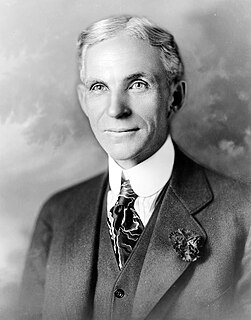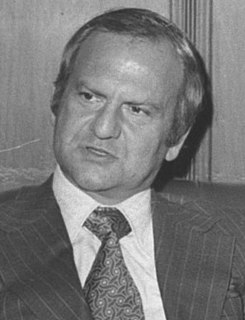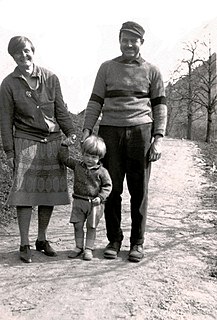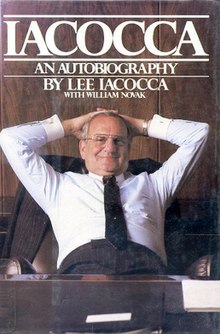
Henry Ford was an American industrialist, business magnate, founder of the Ford Motor Company, and chief developer of the assembly line technique of mass production. By creating the first automobile that middle-class Americans could afford, he converted the automobile from an expensive curiosity into an accessible conveyance that profoundly impacted the landscape of the 20th century.

Walter Percy Chrysler was an American industrial pioneer in the automotive industry, American automotive industry executive and the founder and namesake of American Chrysler Corporation.

Henry Ford II, sometimes known as "HF2" or "Hank the Deuce", was an American businessman in the automotive industry. He was the eldest son of Edsel Ford I and eldest grandson of Henry Ford I. He was president of the Ford Motor Company from 1945 to 1960, chief executive officer (CEO) from 1947 to 1979, and chairman of the board of directors from 1960 to 1980. Under the leadership of Henry Ford II, Ford Motor Company became a publicly traded corporation in 1956. From 1943 to 1950, he also served as president of the Ford Foundation.

Lido Anthony "Lee" Iacocca was an American automobile executive best known for the development of the Ford Mustang and Ford Pinto cars while at the Ford Motor Company in the 1960s, and for reviving the Chrysler Corporation as its CEO during the 1980s. He was president and CEO of Chrysler from 1978 and chairman from 1979, until his retirement at the end of 1992. He was one of the few executives to preside over the operations of two of the Big Three automakers.

The Continental Mark III is a personal luxury car that was marketed by the Lincoln division of Ford Motor Company from the 1969 through 1971 model years. The Mark III was marketed as the flagship vehicle of Ford Motor Company, serving as a successor to the 1956–1957 Continental Mark II. In what would become a three-decade rivalry, the Mark III was developed as a direct competitor to the Cadillac Eldorado after its shift to the personal luxury coupe segment in 1967.

In J. R. R. Tolkien's fictional universe of Middle-earth, the eagles were immense flying birds that were sapient and could speak. Often emphatically referred to as the Great Eagles, they appear, usually and intentionally serving as agents of eucatastrophe or deus ex machina, in his legendarium, from The Silmarillion and the accounts of Númenor to The Hobbit and The Lord of the Rings.

The Plymouth Reliant and Dodge Aries are mid size cars introduced for model year 1981 as the first "K-cars" manufactured and marketed by the Chrysler Corporation. The Reliant was available as a 2-door coupe, 4-door sedan, or as a 4-door station wagon, in three different trim lines: base, Custom and SE. Station wagons came only in Custom or SE trim. Unlike many small cars, the K-cars retained the traditional 6 passenger 2 bench seat with column shifter seating arrangement favored by many Americans. The Reliant was powered by a then-new 2.2 L I4 SOHC engine, with a Mitsubishi "Silent Shaft" 2.6 L as an option. Initial sales were brisk, with both Reliant and Aries each selling over 150,000 units in 1981. As rebadged variants, the Reliant and Aries were manufactured in Newark, Delaware, Detroit, Michigan, and Toluca, Mexico — in a single generation. After their introduction, the Reliant and Aries were marketed as the "Reliant K" and "Aries K".

A bushing or rubber bushing is a type of vibration isolator. It provides an interface between two parts, damping the energy transmitted through the bushing. A common application is in vehicle suspension systems, where a bushing made of rubber separates the faces of two metal objects while allowing a certain amount of movement. This movement allows the suspension parts to move freely, for example, when traveling over a large bump, while minimizing transmission of noise and small vibrations through to the chassis of the vehicle. A rubber bushing may also be described as a flexible mounting or antivibration mounting.

Walter Emmett Flanders was an American industrialist in the machine tool and automotive industries and was an early mass production expert.

The K-car platform was a key automotive design platform introduced by Chrysler Corporation for the 1981 model year, featuring a transverse engine, front-wheel drive, independent front and semi-independent rear suspension configuration—a stark departure from the company's previous reliance on solid axle, rear-drive body on subframe configurations. Derived from Chrysler's L-cars, the Plymouth Horizon and Dodge Omni, the platform was developed just as the company faltered in the market, at first underpinning a modest range of compact/mid-size sedans and wagons—and eventually underpinning nearly fifty different models, including all-wheel drive variants—and playing a vital role in the company's subsequent resurgence.
Kenneth Colin Irving, also known as K. C. Irving, was a 20th-century businessman. K. C. Irving's business began with a family sawmill in Bouctouche, N.B., in 1882. In 1989, he was made an Officer of the Order of Canada.

Robert Anthony Lutz is a Swiss American automotive executive. He served as a top leader of all of the United States Big Three, having been in succession executive vice president of Ford Motor Company, president and then vice chairman of Chrysler Corporation, and vice chairman of General Motors.
Charles Emil Sorensen was a Danish-American principal of the Ford Motor Company during its first four decades. Like most other managers at Ford at the time, he did not have an official job title, but he served functionally as a patternmaker, foundry engineer, mechanical engineer, industrial engineer, production manager, and executive in charge of all production.

Elizabeth Hadley Richardson was the first wife of American author Ernest Hemingway. The two married in 1921 after a courtship of less than a year, and moved to Paris within months of being married. In Paris, Hemingway pursued a writing career, and through him Hadley met other expatriate American and British writers.
Gerhard Neumann was an American aviation engineer and executive for General Electric's aircraft engine division. Born and raised in Germany, he went to China shortly before World War II and ended up being an aircraft mechanic for the United States Army Air Forces there. He became an American citizen by an Act of Congress and went on to a career in the aerospace manufacturing industry.
Stephen Kenneth Hunt is an English former professional footballer who was later known as Steve Evans. A pacey and creativity left-sided midfielder and winger, with long-range shooting ability, he was capped twice for England in 1984.

Equality of sacrifice is a term used in political theory and political philosophy to refer to the perceived fairness of a coercive policy.
In J. R. R. Tolkien's Middle-earth, Faramir is a fictional character appearing in The Lord of the Rings. He is introduced as the younger brother of Boromir of the Fellowship of the Ring and second son of Denethor II, the Steward of the realm of Gondor. The relationships between the three men are revealed over the course of the book and are elaborated in the appendices.

Chrysler, a large automobile manufacturer, was founded in the 1920s and continues today under the name Stellantis North America. The history of Chrysler involves engineering innovations, high finance, wide alternations of profits and losses, various mergers and acquisitions, and multinationalization.
Frederick Morrell Zeder was an American automotive industry engineer and a member of the Automotive Hall of Fame. He made material contributions to Allis-Chalmers and Studebaker. Along with Carl Breer and Owen Skelton, he was one of the core engineering team that formed the present-day Chrysler Corporation. His innovations included rubber motor mounts that contributed to Chrysler's success. He was the first president of Chrysler's Institute of Engineering.














